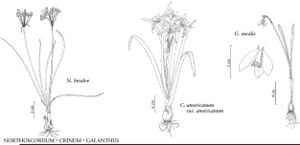Nothoscordum bivalve
in N. L. Britton and A. Brown, Ill. Fl. N. U.S. 1: 415. 1896.
Bulbs globose to subglobose, to 1–1.5 cm diam.; outer coats brown; bulblets absent. Scape solitary (rarely 2), terete, (10–) 20–40 cm × 1–3 mm. Leaves 1–4, sheaths enveloping neck of bulb, hyaline, subtruncate apically; blade filiform or linear, to 30 cm × 1–4 (–5) mm, margins entire. Umbel mostly 3–6 (–10) -flowered, often asymmetrical, 1–3 cm diam.; bracts persistent, 2, 1–2 cm × 4–8 mm, base coherent, imbricate, margins scarious or hyaline, apex acuminate. Flowers not fragrant; tepals whitish to cream, at least outer ones with red or purplish red midvein, elliptic, (8–) 10–12 (–15) × 3–4.5 mm, apex acute or acuminate; filaments simple, adnate to tepals, 5–6 mm; anthers yellow; ovary crestless; style persistent, equaling stamens; stigma unlobed, 3/4 perianth; pedicel erect, 1–2 cm, elongating as flowers develop, but often of several lengths even in fruit. Capsules subglobose or obovoid, 6–8 × 6–8 mm. Seeds 4–7 per locule.
Phenology: Flowering Mar–Dec.
Habitat: Open woods, prairies, barrens
Elevation: 0–1700 m
Distribution

Ala., Ariz., Ark., Fla., Ga., Ill., Ind., Kans., Ky., La., Miss., Mo., N.Mex., N.C., Ohio, Okla., S.C., Tenn., Tex., Va., s to South America
Discussion
Selected References
None.
Lower Taxa
"elongating" is not a number."thicker" is not a number.
